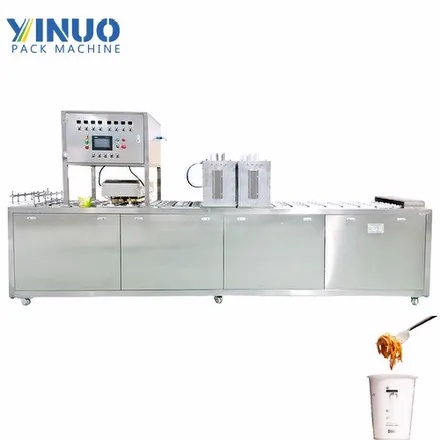Automatic filling and sealing machines are essential pieces of equipment in modern packaging industries. From food and beverages to pharmaceuticals and cosmetics, these machines streamline production by efficiently filling containers with liquid, powder, or granulated products and sealing them for safe distribution.
If you’ve ever wondered how these machines work, what components they include, and why they’re so important to manufacturing efficiency, this guide will explain everything you need to know.
An automatic filling and sealing machine is a type of industrial equipment designed to automatically measure, fill, and seal various types of packaging—such as pouches, bottles, tubes, or cups—without manual intervention.
These machines are widely used in industries like:
Food & beverage (juice, milk, sauces, coffee, snacks)
Pharmaceuticals (syrups, powders, capsules)
Cosmetics (creams, lotions, gels)
Chemicals (detergents, lubricants, oils)
By integrating precise filling technology with efficient sealing systems, these machines improve productivity, accuracy, and hygiene standards.
The working process of an automatic filling and sealing machine typically involves several automated stages:
Empty containers or pouches are automatically fed into the machine using a conveyor or rotary indexing table. Some machines use robotic arms for precise placement.
Depending on the product type, different filling methods are used:
Liquid filling: Uses piston, gravity, or pump systems.
Powder filling: Uses auger fillers for precise dosing.
Granule filling: Uses volumetric cups or weighers.
The product is measured accurately and dispensed into each container or pouch.
Once filled, the machine seals the package using one of the following methods:
Heat sealing: Common for pouches and sachets; seals the edges using heat and pressure.
Induction sealing: Uses electromagnetic induction to seal foil caps on bottles.
Ultrasonic sealing: Uses high-frequency vibration for fast, clean seals.
Optional printers or labelers can add batch codes, expiry dates, or branding labels as part of the process.
The finished, sealed products are automatically discharged onto a conveyor belt for packaging, boxing, or further processing.
Hopper or Product Tank: Stores the product before filling.
Filling Nozzles or Dosing System: Accurately measures and dispenses the product.
Sealing Unit: Applies heat, pressure, or ultrasonic energy for sealing.
Conveyor System: Moves containers through each processing stage.
PLC Control Panel: Manages automation, settings, and monitoring.
Sensors and Actuators: Ensure precision and detect errors like underfilling or misalignment.
Date Coding and Labeling System (Optional): For branding and traceability.

Depending on the product and packaging style, the main types include:
Used for juices, water, milk, oils, and chemicals. They employ piston or pump-based fillers for high-speed, accurate filling.
Explore more:Ideal for flour, coffee, spices, and pharmaceutical powders. Auger fillers and screw dosing systems ensure uniform quantities.
Used for sugar, rice, nuts, and snacks. These use volumetric cups or electronic weighers for consistent filling.
Form-fill-seal (FFS) systems create pouches from film rolls, fill them, and seal them in one continuous process.
Used in beverage and cosmetic industries. These machines fill bottles, cap them, and seal them using induction or heat processes.
High Efficiency: Continuous operation with minimal human input.
Precision and Consistency: Accurate dosing reduces product waste.
Improved Hygiene: Automated systems minimize contamination risks.
Cost-Effective: Reduces labor costs and increases output.
Versatile: Handles a wide range of products and packaging types.
Customizable: Can be integrated with labeling, coding, and inspection systems.
User-Friendly Interface: PLC control allows easy operation and adjustments.
Automatic filling and sealing machines are used across many industries, including:
Food Industry: Sauces, snacks, coffee, spices, dairy, condiments
Pharmaceutical Industry: Syrups, tablets, capsules, powders
Cosmetics Industry: Creams, lotions, gels, shampoos
Chemical Industry: Detergents, fertilizers, motor oils, solvents
Beverage Industry: Juices, bottled water, energy drinks
Regular Cleaning: Prevent product residue from clogging nozzles or sealing heads.
Lubrication: Keep moving parts well-lubricated to reduce wear.
Calibration: Check filling accuracy regularly.
Inspection: Monitor sealing temperature and pressure for consistent results.
Operator Training: Ensure staff understand operation and safety protocols.
Smart Automation: Integration of sensors, IoT, and AI for predictive maintenance.
Energy Efficiency: Machines designed to reduce power consumption.
Sustainability: Compatibility with biodegradable and recyclable packaging materials.
Digital Monitoring: Real-time performance tracking via cloud-based dashboards.
Modular Design: Easy customization for different products and package formats.
Automatic filling and sealing machines have revolutionized the packaging industry by combining speed, accuracy, and reliability in one system. Whether handling liquids, powders, or granules, these machines ensure consistent product quality and cost-effective operation.
Understanding how they work helps manufacturers choose the right model for their needs and maintain smooth, efficient production.
Previous: How to Choose an Automatic Meat Paste Filling and Sealing Machine
Next: Оптовая покупка зажимов в форме Великой стены: лучшие предложения и советы
Comments
Please Join Us to post.
0